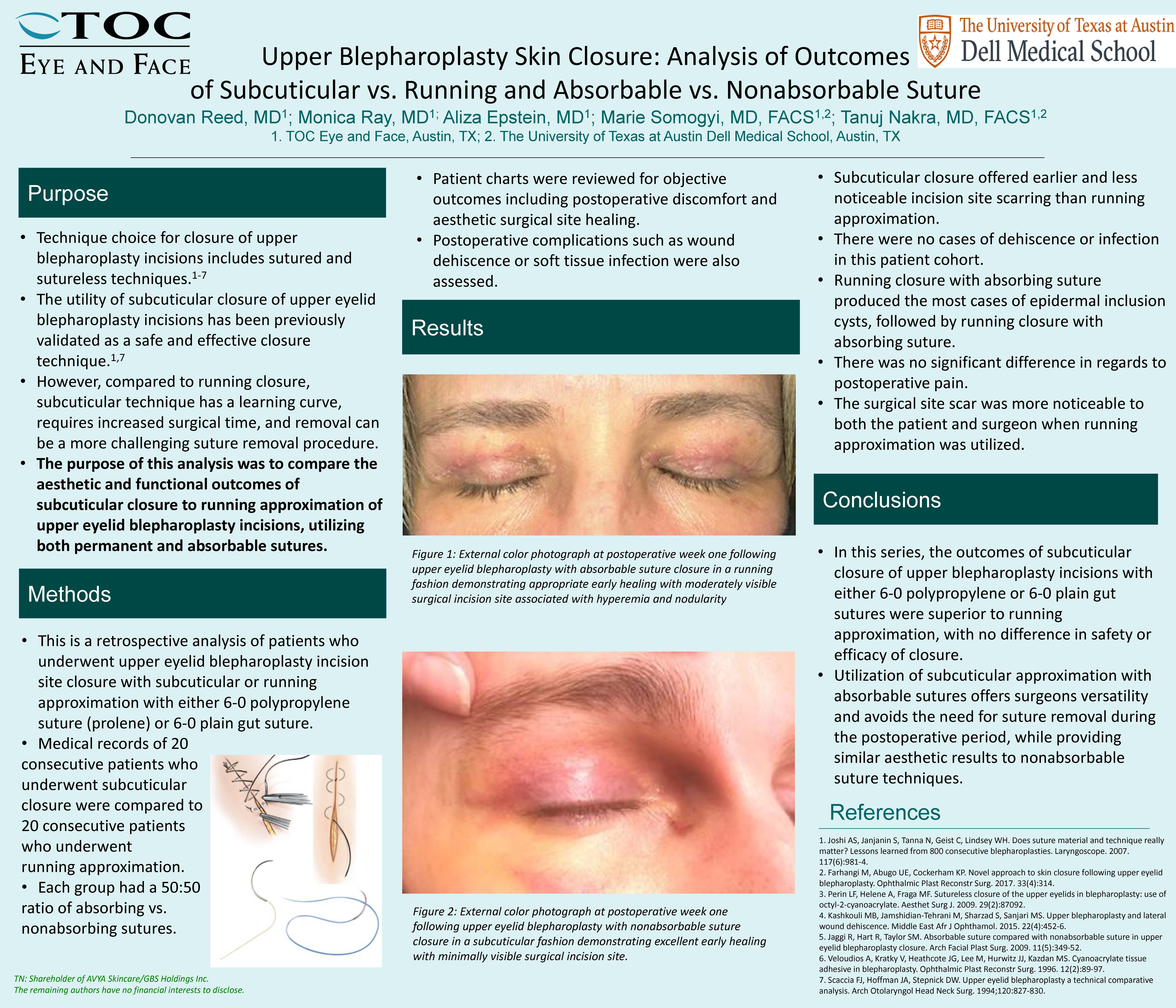
Speaker
 Donovan S. Reed, MD
Donovan S. Reed, MD
Texas Oculoplastics Consultants - TOC Eye And Face, Austin, TX
Doctor Donovan Reed graduated Summa Cum Laude with Honors from East Tennessee State University with a degree in Chemistry. He then commissioned as an officer in the United States Air Force and graduated as class Valedictorian from the Uniformed Services University where he was elected to Alpha Omega Alpha. Doctor Reed completed his Internship in General Surgery and his Ophthalmology Residency at the San Antonio Uniformed Services Health Education Consortium where he served as Chief Resident of the Ophthalmology Residency. During his residency training, he was awarded the USAF Commendation Medal for meritorious service and named best ophthalmology resident and received the Major David S. Berry Graduate Medical Education Top Resident Award. Dr. Reed is a board-certified ophthalmologist and is the current American Academy of Cosmetic Surgery Facial Cosmetic Surgery fellow at Texas Oculoplastics Consultants, TOC Eye & Face under the guidance of Tanuj Nakra MD.
Abstract
Introduction: Technique choice for closure of upper blepharoplasty incisions includes sutured and sutureless techniques.1-7 The utility of subcuticular closure of upper eyelid blepharoplasty incisions has been previously validated as a safe and effective closure technique.1,7 However, compared to running closure, subcuticular technique has a learning curve, requires increased surgical time, and removal can be more challenging suture removal procedure. Furthermore, absorbing sutures The purpose of this analysis was to compare the aesthetic and functional outcomes of subcuticular closure to running approximation of upper eyelid blepharoplasty incisions, utilizing both permanent and absorbable sutures.
Methods: This is a retrospective analysis of patients who underwent upper eyelid blepharoplasty incision site closure with subcuticular or running approximation with either 6-0 polypropylene suture (prolene) or 6-0 plain gut suture. Medical records of 20 consecutive patients who underwent subcuticular closure were compared to 20 consecutive patients who underwent running approximation. Each group had a 50:50 ratio of absorbing vs. nonabsorbing sutures. Patient charts were reviewed for objective outcomes including postoperative discomfort and aesthetic surgical site healing. Postoperative complications such as wound dehiscence or soft tissue infection were also assessed. PLEASE PROCEED WITH UT-AUSTIN IRB
Results: Subcuticular closure offered earlier and less noticeable incision site scarring than running approximation. There were no cases of dehiscence or infection in this patient cohort. Running closure with absorbing suture produced the most cases of epidermal inclusion cysts, followed by running closure with absorbing suture. There was no significant difference in regard to postoperative pain. The surgical site scar was more noticeable to both the patient and surgeon when running approximation was utilized.
Conclusions: In this series, the outcomes of subcuticular closure of upper blepharoplasty incisions with either 6-0 polypropylene or 6-0 plain gut sutures were superior to running approximation, with no difference in safety or efficacy of closure. Utilization of subcuticular approximation with absorbable sutures offers surgeons versatility and avoids the need for suture removal during the postoperative period, while providing similar aesthetic results to nonabsorbable suture techniques.
Bibliography:
- Joshi AS, Janjanin S, Tanna N, Geist C, Lindsey WH. Does suture material and technique really matter? Lessons learned from 800 consecutive blepharoplasties. Laryngoscope. 2007. 117(6):981-4.
- Farhangi M, Abugo UE, Cockerham KP. Novel approach to skin closure following upper eyelid blepharoplasty. Ophthalmic Plast Reconstr Surg. 2017. 33(4):314.
- Perin LF, Helene A, Fraga MF. Sutureless closure of the upper eyelids in blepharoplasty: use of octyl-2-cyanoacrylate. Aesthet Surg J. 2009. 29(2):87092.
- Kashkouli MB, Jamshidian-Tehrani M, Sharzad S, Sanjari MS. Upper blepharoplasty and lateral wound dehiscence. Middle East Afr J Ophthamol. 2015. 22(4):452-6.
- Jaggi R, Hart R, Taylor SM. Absorbable suture compared with nonabsorbable suture in upper eyelid blepharoplasty closure. Arch Facial Plast Surg. 2009. 11(5):349-52.
- Veloudios A, Kratky V, Heathcote JG, Lee M, Hurwitz JJ, Kazdan MS. Cyanoacrylate tissue adhesive in blepharoplasty. Ophthalmic Plast Reconstr Surg. 1996. 12(2):89-97.
- Scaccia FJ, Hoffman JA, Stepnick DW. Upper eyelid blepharoplasty a technical comparative analysis. Arch Otolaryngol Head Neck Surg. 1994;120:827-830.
Take Home Message
Utilization of subcuticular approximation with absorbable sutures offers surgeons versatility and avoids the need for suture removal during the postoperative period, while providing similar aesthetic results to nonabsorbable suture techniques.
